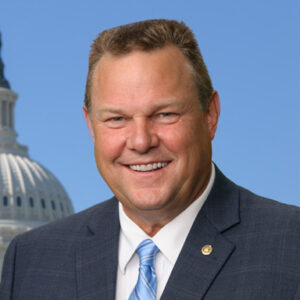When drop 5 on the St. Mary Unit of the Milk River Project failed in May 2020, a large group of stakeholders, including the Milk River Joint Board of Control (MRJBOC), the Bureau of Reclamation, and the State of Montana came together to address the problem and repair the structure. Montana’s delegation to Congress— Senators Steve Daines and Jon Tester and Congressman Greg Gianforte—also played a key role in coordinating efforts and pushing forward legislation to address the situation. In this interview, we speak with Senators Daines and Tester and Congressman Gianforte, who was recently elected governor of Montana, about their involvement in the drop 5 reconstruction and their legislative efforts to aid the Milk River Project.
Senator Steve Daines
 Irrigation Leader: Please tell us about your experience over the past few months working to secure funding and help for the Milk River Project.
Irrigation Leader: Please tell us about your experience over the past few months working to secure funding and help for the Milk River Project.
Steve Daines: The catastrophic failure of drop 5 on the St. Mary Unit was a perfect example of why we needed a legislative change in the cost share. Thankfully, we saw great bipartisan collaboration and partnership among Congress, the Trump administration, and the stakeholders, all moving toward the same goal of expediting water delivery. Progress toward that goal was further aided by administrative relief. Working together in good faith is what led to the reconstruction of the Milk River Project as fast as it occurred, and that same momentum and collaboration is now needed to push legislation forward.
Irrigation Leader: What has your experience working with the Bureau of Reclamation and the U.S. Department of the Interior been like?
Steve Daines: Reclamation and Interior have been fantastic to work with. Throughout the entire process, they were flexible and communicated regularly, turning over every rock to look for additional ways to help streamline the project and reduce the burden on the Montanans who were in dire need of this fix.
Irrigation Leader: What was it like to be at the drop 5 ribbon cutting?
Steve Daines: It was exciting to celebrate a huge bipartisan accomplishment and to finally see water running through the canal again. I had been there earlier in the summer, and the difference was monumental, showing that months of hard work and coming together had paid off. It was a great moment to celebrate that success and what it means for Montana water users and irrigators.
Irrigation Leader: What will the effects of the drops 2 and 5 reconstruction be?
Steve Daines: The quick and timely reconstruction of drops 2 and 5 means that the farmers, ranchers, water users, and tribes on the Hi-Line will all have access to clean water again. This is also a great example of how we can come together in a bipartisan fashion and quickly turn around major projects to help Montanans in need.
Irrigation Leader: What are the current prospects for S. 1305, the St. Mary’s Reinvestment Act?
Steve Daines: I’ve been working extensively with my colleagues on the Senate Energy and Natural Resources Committee to get the St. Mary’s Reinvestment Act through committee and to the Senate floor for a vote. We have to get this past the finish line. I’ll continue to work with the entire delegation and Senate leadership to push this through as soon as possible to prevent another catastrophic failure from happening in the future.
Governor-Elect Greg Gianforte
 Irrigation Leader: Please tell us about your experience over the past few months working to secure funding and help for the Milk River Project.
Irrigation Leader: Please tell us about your experience over the past few months working to secure funding and help for the Milk River Project.
Greg Gianforte: It’s been an honor to advocate for Montana producers in Congress for the last 3 years, and I’m looking forward to continuing that work as Montana’s next governor. Before the failure of drop 5, we had been working with Interior to secure funding and upgrades for important infrastructure projects like this one. In May 2020, when drop 5 failed, it became an immediate priority of ours. In collaboration with local irrigators, the State of Montana, and the Trump administration, we were able to secure the funding needed to get water flowing through the Hi-Line again.
Irrigation Leader: What has your experience working with Reclamation and Interior been like?
Greg Gianforte: We couldn’t have accomplished this without everyone coming together to push this forward. Both here in Montana and back in Washington, Assistant Secretary Petty and Commissioner Burman and their teams were eager to help us solve the issue.
Irrigation Leader: What was it like to be at the drop 5 ribbon cutting?
Greg Gianforte: The ribbon cutting was a culmination of the hard work and collaboration it took to get this project done. It was great to be there to see the water flowing back through the Milk River Project, which directly supports Montana producers, tribes, and Hi-Line communities.
Irrigation Leader: What will the effects of the drops 2 and 5 reconstruction be?
Greg Gianforte: When drop 5 failed in May, folks weren’t sure their faucets were going to work anymore. Getting water flowing again through the Milk River Project has been a critical lifeline for the Montana farmers, ranchers, towns, and tribes that depend on the project for water.
Senator Jon Tester
 Irrigation Leader: Please tell us about your experience over the past few months working to secure funding and help for the Milk River Project.
Irrigation Leader: Please tell us about your experience over the past few months working to secure funding and help for the Milk River Project.
Jon Tester: It’s no secret that funding for the Milk River Project is long overdue—I’ve been fighting for it since I was in the state legislature. But over the last few months, especially with the emergency work on drops 2 and 5, Montanans have really come together and are sending a strong message to folks in Washington, DC, that this project needs rehabilitation as soon as possible. I’ve been really impressed by the leadership from the Milk River Joint Board of Control (MRJBOC) and the St. Mary Rehabilitation Working Group. They managed to get everyone pulling in the same direction under tight timelines, including state, federal, and tribal partners, and it has paid off big time.
Irrigation Leader: What has your experience working with Reclamation and Interior been like?
Jon Tester: Reclamation staff really understand the importance of the Milk River Project and what it means for Montana’s Hi-Line. In response to the emergency at drop 5, they were quick on their feet to get teams deployed and worked quickly to release extraordinary maintenance funding. There’s always going to be some wrangling over budget constraints and costs when we start talking about legislation, but I’m glad Reclamation has been at the table.
Irrigation Leader: What was it like to be at the drop 5 ribbon cutting?
Jon Tester: It was really great to see all the hard work over the course of this year pay off. You don’t often see a coalition this broad coming together to pull for the same thing, which emphasizes how important the Milk River Project is for Montana. That being said, it was also pretty sobering. The Milk River Project is over a century old, and we absolutely need to be doing aggressive rehabilitation work across the system to prevent catastrophic failures going forward. The teams found some severe erosion during reconstruction, which really emphasizes the fact that there may well be other elements of the system that are teetering and that we need real federal support to head that off at the pass.
Irrigation Leader: What will the effects of the reconstruction of drops 2 and 5 be?
Jon Tester: The reconstruction of drops 2 and 5 means that the Milk River Project can continue operating. That sounds simple, but it means that we’ll still have 148,000 irrigated acres, we’ll be able to honor tribal water rights, and four northern Montana towns will continue to have access to municipal water supplies. This project is the backbone of the Hi-Line, and getting it back online is absolutely essential for thousands of people. Getting the system operational again is a huge win, and we need to roll with this momentum into continued rehabilitation work across the system.
Irrigation Leader: What are the current prospects for S. 1305, the St. Mary’s Reinvestment Act?
Jon Tester: We’ve had some good progress over this year, from a hearing with Reclamation to a deep dive on the bill with the Senate Energy and Natural Resources Committee and the MRJBOC. The emergency this summer really lit a fire in the Senate, and I think we’re poised for some action on the bill at the start of 2021.
Steve Daines is a United States Senator from Montana. For more information about Senator Daines, visit daines.senate.gov.
Greg Gianforte represented Montana in the U.S. House of Representatives from 2017 to 2021 and will be sworn in as governor of Montana on January 4, 2021. For more about Governor-elect Gianforte, visit montanacomeback.com.
Jon Tester is a United States Senator from Montana. For more information about Senator Tester, visit tester.senate.gov.
